Hey there motorcycle enthusiasts! In this video, I'll be doing a complete in-depth review of the brand new 2023 Kawasaki Vulcan Vaquero. This bike is sure to turn heads with its cutting edge style and performance. So whether you're looking for your first bike or are just curious about what's out there, make sure to stick around because you won't want to miss this.
So make sure you subscribe for that. So let's get going with the review of this bike. So the first thing that stands out to people about this bike is the style. And although it's based on the Vulcan Voyager or they're both kind of built on the same basic platform, basically the exact same platform, they look completely different. And a lot of that comes down to this paint color here, which is kind of this sort of matte gray black, I'll put the name of it on the screen here for you cuz I don't even remember what Kawasaki calls some of their paint colors. But what's cool about it is this isn't just a paint color for other people to see. They carry it through to the dash side, which we'll show you in a little bit. So you get to enjoy that color yourself, not just on the tank, but right through sort of the interior of the dash.
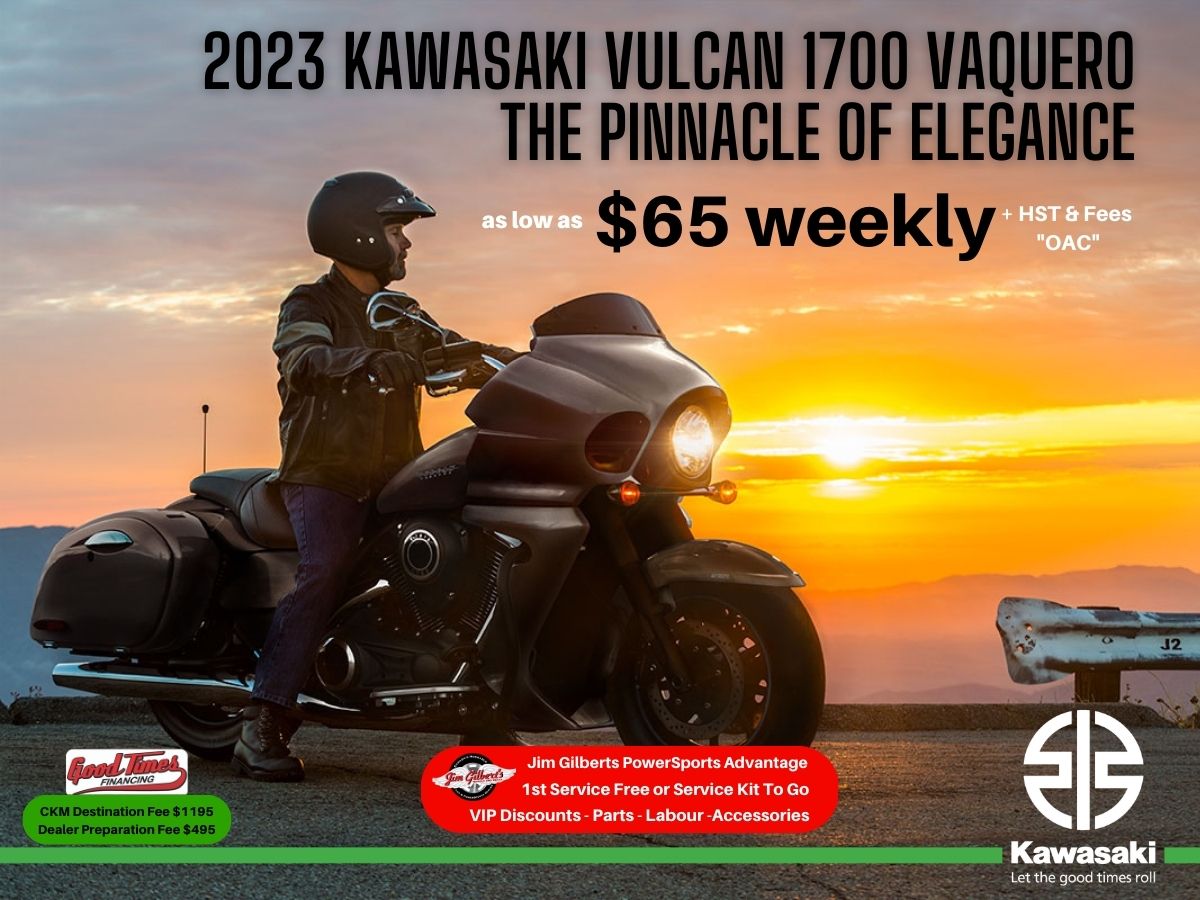
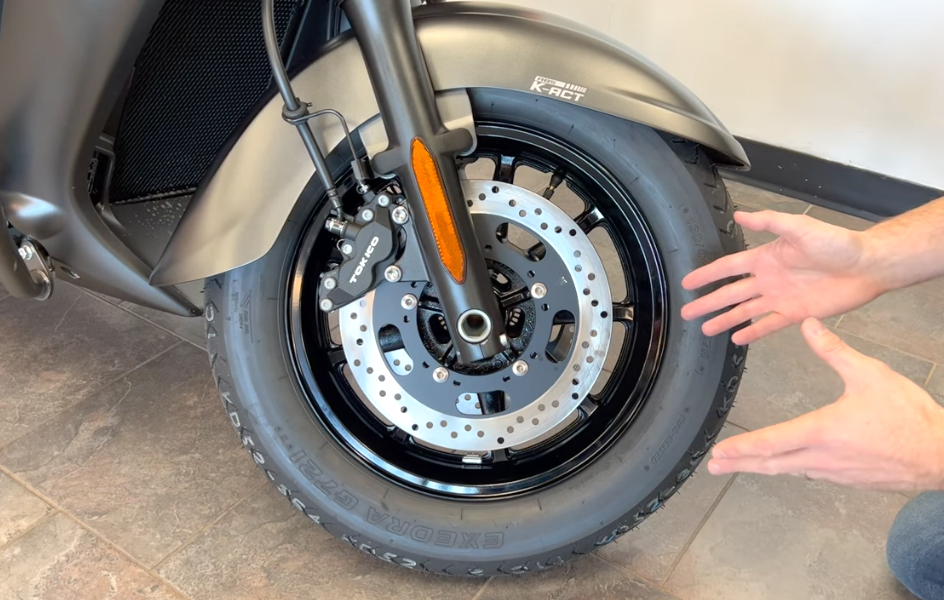
This one's got the same size disc in the back. Now they are a little bit different brakes front and rear and that makes sense because of weight transfer and everything else. So look, weight transfer is really what this K act is about. K dash a c t. This is an a BS braking system. So first of all you have a modern ABS braking system. It is tied to a computer and the computer does a couple things that of course help ABS sort itself out. Anytime you have ABS you need a computer anyways. But this one is a more advanced system with extra pieces in there that allow you to have a linked braking system depending on speed and everything else. So if you jam on the foot pedal brake, which would normally be just your rear brake, it's going to put power to the front to keep you, uh, keep the braking balance and it's gonna make a decision on that based on the number of factors, speed of the bike and that kind of thing.
And the same thing happens if you grab uh, a whole bunch of front brake. It's gonna balance out that braking front and rear. So in an emergency situation with a heavy bike like this, that's often where you get into some trouble and this braking system is built for Kawasaki's heavier bikes. They don't use this type of braking system on anything else other than these bigger, heavier bikes and it allows you to keep better control. So it's ABS and a linked braking system, which means an emergency situation. If you grab too much foot brake, too much hand brake, whatever you're grabbing, uh, it will balance that out as best as it can and work with your ABS system to help you keep control. It's a pretty advanced braking system and braking is a big deal on a big heavy motorcycle like this. So really gotta give Kawasaki credit for this braking system here inside here there's some alloy style wheels.
Hard to see there with those large brake discs, uh, but some extra little styling when you come up close. Let's take a look back and look at some of the styling on the front as we move through some of the features as well through the motorcycle. So taking a look at the front of the bike, you've got some nice sort of classic styling here. Now you do have options here. These are not actually functional vents, they look pretty cool, but you have the option of filling these in just like on the voyager with extra driving light. So you've got that option. If you don't do it, it looks cool, but again, just remember they're not functional vents coming down here. This is a liquid cooled engine that's gonna be good for all kinds of reasons. Uh, big thing is it's keeps that engine temperature consistent.
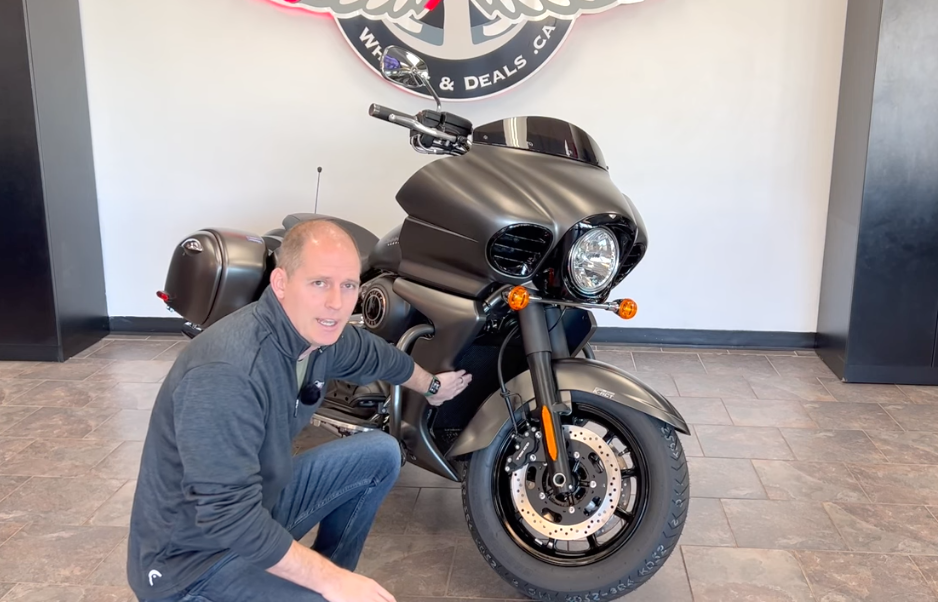
Like I said, it's got that air cooled look to it, which is pretty cool. You've got a really good mix of black inside the engine to make the fin stand out black on here and then chrome as well. So you've got sort of that black, that dark gray kind of mix and the chrome all mixing together to really make the pieces stand out, give it some visual presence. It's just super cool up close. So again, big chrome pipes down here and the chrome does tie into other pieces of the bike front and rear, which is cool. But again, that sort of dark gray paint with the black engine really goes well together. Now one thing I wanna point out is let's talk about a vwe engine like this. They are supposed to have some rumble. So this is what I talked about when I started off with this uh, video is you can't make it so refined that it just doesn't have any feel to it.
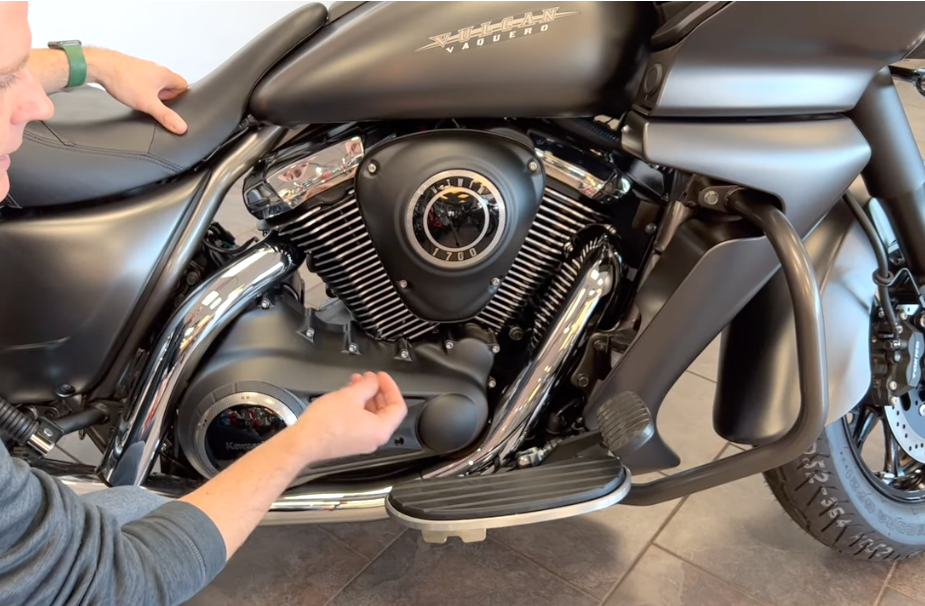
The body work is a little bit closer so your feet are out in the wind, which on a hot day I think is a little bit nicer. Uh, you can obviously, you know, do a number of things to keep warm on a cool day or that kind of thing. But having that crash bar come out and protect without the body work I think makes this look a little bit sleeker, a little bit sportier rather than something that uh, Voyager, which is more of a tour, although there's no difference in this bike, you can tour just as easily with that. Just wanna come around to the other side. I didn't point out this V twin 1700, that's of course on the other side as well. It's an identical badge there. Down here on the other side you had a Kawasaki badge, but here is a six speed and that six speed is something I want to talk about in those six gears.
Of course, one down five up is uh, and if you have a heeled toll shifter here as well, but the gearing here is first through fourth or building gears fifth and six are overdrive gears. Now with all the torque you have, you can still pass in fifth gears still pass in six gear, not a problem. But really first through fourth are what you're gonna use to get going, to get moving anywhere you need to go. And those overdrive gears are gonna give you efficiency as well as sort of, you know, dial it down on the highway to just give you that nice sort of, you know, calm feeling, which is what you get with a 1700 cc v twin bike is that ability to just have that calm highway cruising. But like I said, you've got the power where you need it and uh, that six speed really just makes it a nicer vehicle to drive.
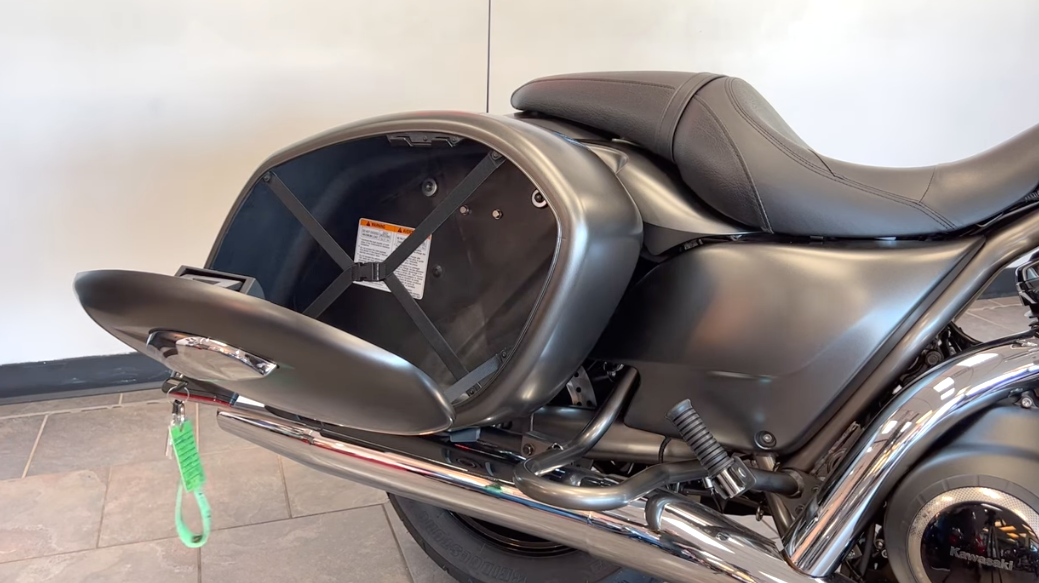
Now you can get the floorboards if you want. That comes standard on the Voyager. They're an accessory from Kawasaki. So don't let that deter you. If you are taking a passenger regularly, uh, you can do that. And again, there are multiple seat options. There's more of a solo seat, there's more of a um, like a gel seat. There's options to, to change this up to be whatever you need it to be. If you're riding solely, you're probably never gonna worry about this cuz you can take a passenger, we need to. But if you're doing longer tours and you want to get, you know, a back wrist on here or other things, uh, and you know, set it up for a passenger, don't worry, you can do that. A little hard to see on camera here, but you've got more crash birds here that come out beyond your luggage.
And I'm gonna try to do the luggage on camera here. Now let's just show you one thing with the key here. The keys to me don't match the motorcycle as far as the size of it. There's a little thicker key to a lot of Kawasaki keys, but that's not gonna matter and I'll show you why in a second. But the shape of it you can sort of see there is very similar to the shape of your bags there, which is kind of cool. So this is the ignition key, it's a key matched here. I'm gonna turn it in here, we're gonna unlock it. And then this is a handle you pull up and you have pretty good uh, storage in there. Can you see it there? Yeah, perfect. You can sort of see it. So you have this uh, bungee stored here. You can get as an accessory, an inner liner bag. So if you weren't concerned about things that you know, you have that fall outta here, you can get an inner bag that fits there. So you can just take that entire bag out if you want. Uh, also to take your stuff inside. That might be
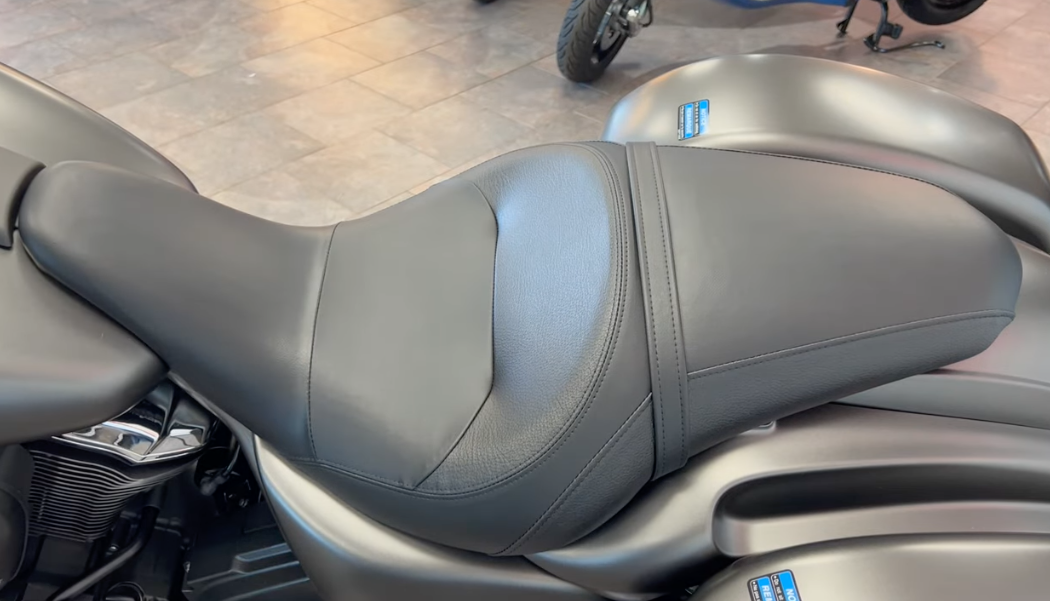
And of course the rider as well. Let's take a look at the driver's environment now because there's a lot going on in that area that we don't always talk about. So the very first thing I wanna show you, and this is something that I think people leave out sometimes is the ignition. Of course you can turn it on with the key like that and then you can pull your key out and take your key and put it in your pocket or wherever you want. And the reason that's nice is because you don't have all your other keys or other your things, um, dangling around, clicking around, scratching around anything else. So you can take that key out, it's designed to do that. And you can see here I can easily turn it back, uh, and turn it off by myself without the key. So really cool design there.
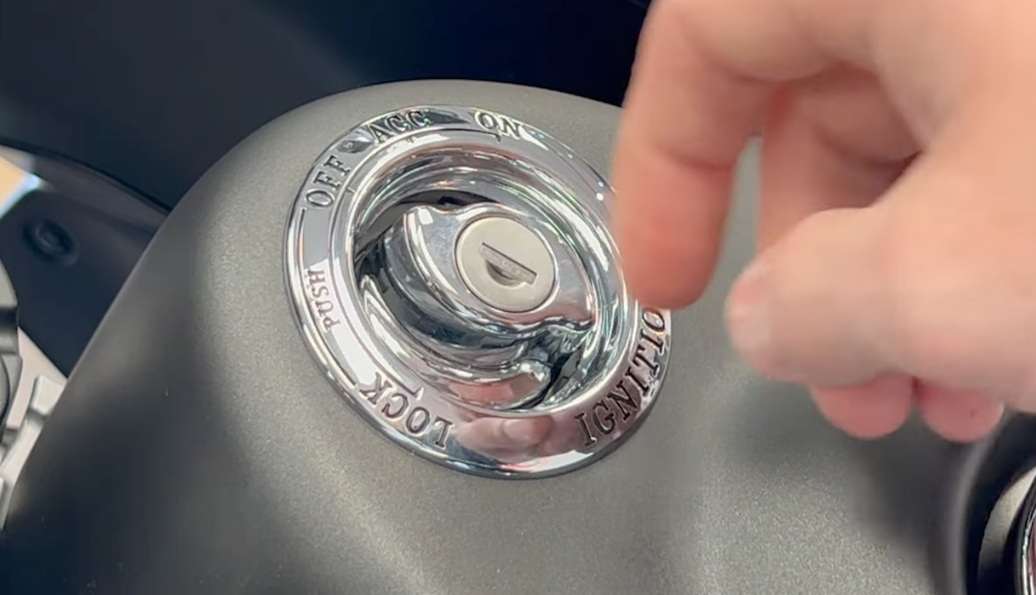
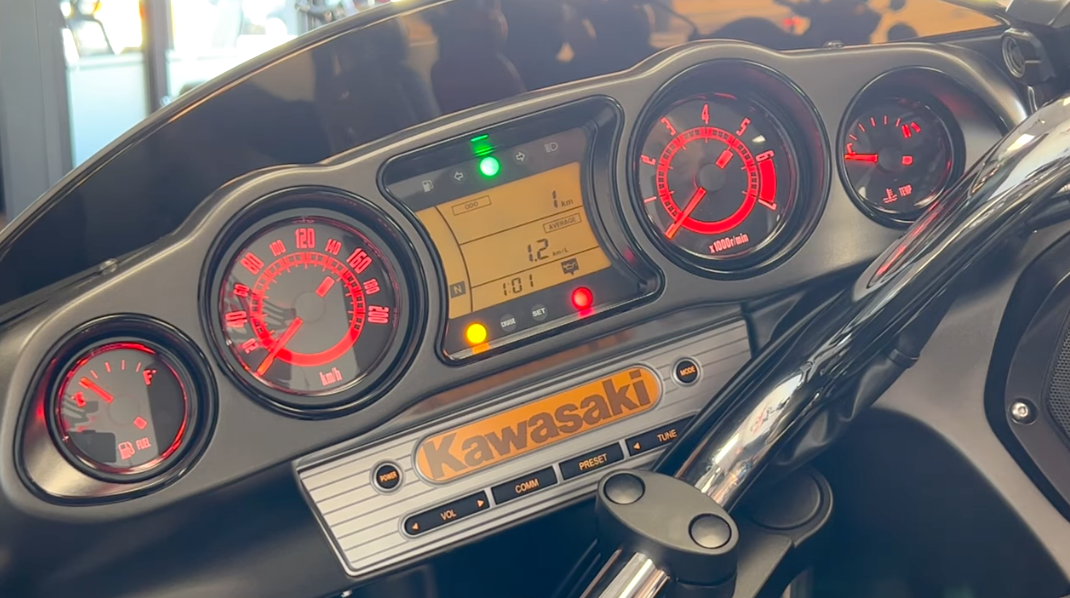
And I'm gonna show you there's a, uh, toggle switch I'll show you in a second when we show you the handlebars. But I want you to look sort of over here and over here there's a switch where if I move to the left, I will switch this stuff up here, your odometer right now. So right now it says odometer and hopefully you can read that it's now switching to, um, oops, I'm going the wrong way. So <laugh>, we're actually down here. Uh, let's go to the top side. If I pull it to the right, the switch that I'm gonna talk about, if I pull it to the right, I can go through odometer, trip A, trip B and that's it. Now if I push it to the left, you probably already saw this, there's a couple things in there. There's the average kilometers per liter, I believe you can change that to leaders per hundred kilometers if that's what you want.
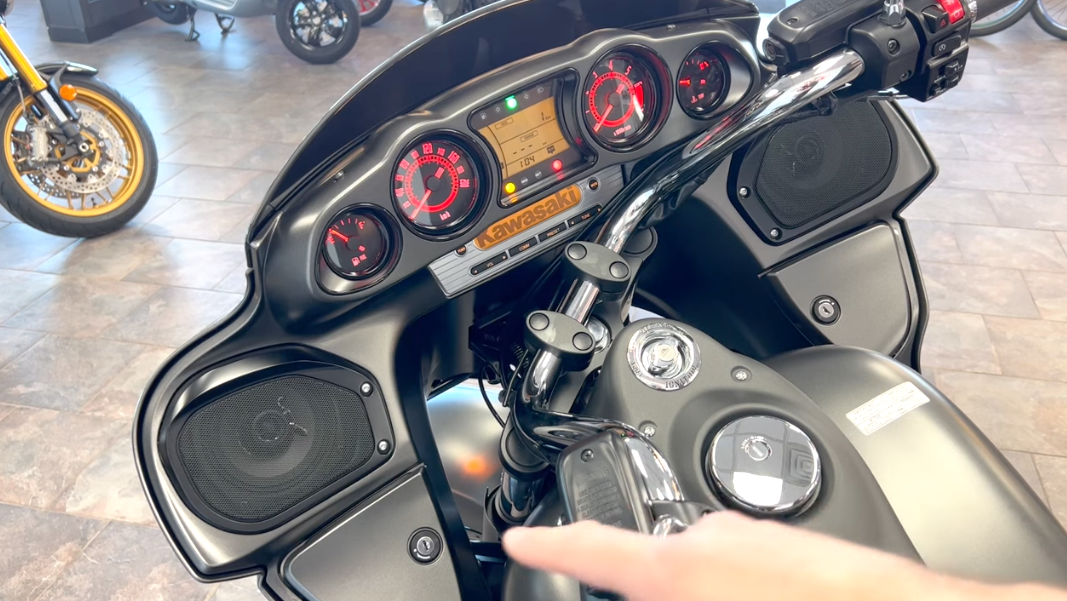
So you've got a 6,000 RPM red line on this engine here and of course your max torque is about 27 50. So it's way down here. So you're just revving this bike in about a thousand RPM range to get most of your idle through, you know, pretty good torque. Uh, and that just is part of the fun of these bikes is they don't have a quick revving four cylinder engine, but you've got that torque that builds that sound that builds. And again, rear real clear gauges there. Temperature gauge over here. So just in case you didn't see it, fuel gauge, uh, speedometer, tachometer temperature gauge. And again, you may not notice it on your screen because it's sort of the grayish color, but this grayish color is the same color that's on the front and the sides of the bike. So you don't just see the color on the tank, you see it throughout the dash here, which you know you're paying for that for a reason.
Taking a look down here, you've got your stereo system. The stereo system is actually very clear. I haven't got it, uh, turned up very loud right now just cause I don't want it to jump into my microphone here. But you've got FM am you've got a weather band radio, uh, and then you can add communication system, you can add other, uh, things like a Bluetooth device as well. And that of course, uh, allows you to uh, connect different things like communication systems, connect, uh, CB radio, you can connect up to this bike. Uh, so all those things that's sort of pre-wired for and pre-set up for, but of course am FM radio with the speakers there is standard. Let's zoom out a little bit and get a little view of the overall dash and then uh, we'll take a look at some of the individual pieces of this dash as well.
So taking a top down look at the bike, just uh, zooming out a little further. You can see those speakers right there. They're well placed. You do have two little storage compartments here. Now they're identical except this one here has the wiring in there. Can you see the wiring? Yeah, there we go. The very bottom, you can see the wiring in there. Uh, obviously you can leave the bike running. Take your key out to open those up if you need. This wiring is basically for audio type connections, whether it's a communication system, Bluetooth, uh, enabled devices, that kind of thing. Uh, you've got that in the left side pocket. The right side pocket is identical without the wiring in there. So just something to keep in mind. Um, and again, some people have said in uh, other reviews that, you know, they wish those weren't lockable.
But again, you don't have to turn your bike off to get them because you can pull the key out while it's running. Get inside and outta there, no problem at all. The other thing I'll really quickly point out is both sides have the speaker, then they have this door, and then below that is a little potential 12 volt port. So this one here is uh, just a blank right now and it's the same thing on both sides. Below these little doors on both sides of the vehicle, you can add a little USB or 12 volt port, I assume just 12 volt port by, you know, other cows hockey bikes have USB options as well. So haven't checked into that, but definitely a 12 volt port down there. Now let's look at the handlebars and the controls there because you get extra functions on a bike like this.
So taking a look at the left side here, this is your clutch lever here. First of all, you've got a nice sort of meaty clutch feeling there. So larger, uh, clutch handle, like the clutch lever there and larger grip here. These aren't carryover pieces from other, you know, Kawasaki sport bikes or something like that. They feel the part, you know, they're, they do their job. Same thing with the horn button here, different horn button, it's large, it's up there. Different lights over here or different buttons for the lights here. So on some of the sport bikes you have a trigger to flash your hive. Don't have that here. I would've liked to see that, but you know, it is what it is. You do have low and high beam right there, signal lights right there. And then you have this set of controls here. This is your volume for your stereo, this is your tuning for your stereo and then you have your squelch for a CB that you could add at a later time.
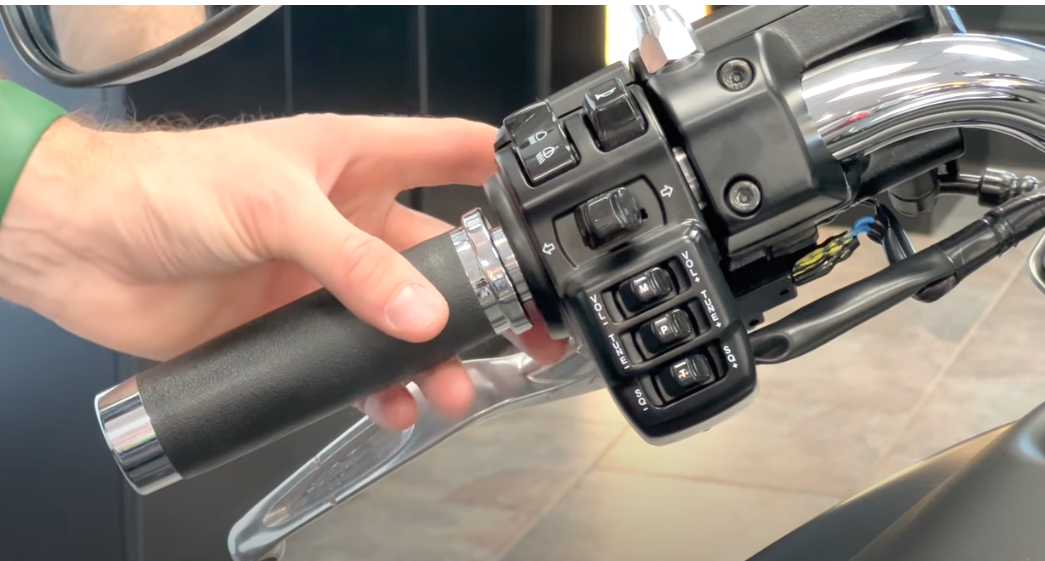
But because you've got those volume and those tuning those other controls, you've kind of got enough controls there. So they move it over here. There's a start switch down there right below the kill switch. And then you've got the switch right here, moving it left controls the, I think the middle section, moving it right controls the upper section of that dash that we showed you. So that was the odometer, the fuel efficiency type gauges in that center display screen, uh, dash, uh, you can just, uh, quickly get at a glance. So again, left side is I believe the middle. Moving it to the right side here is cycles through the top section of the
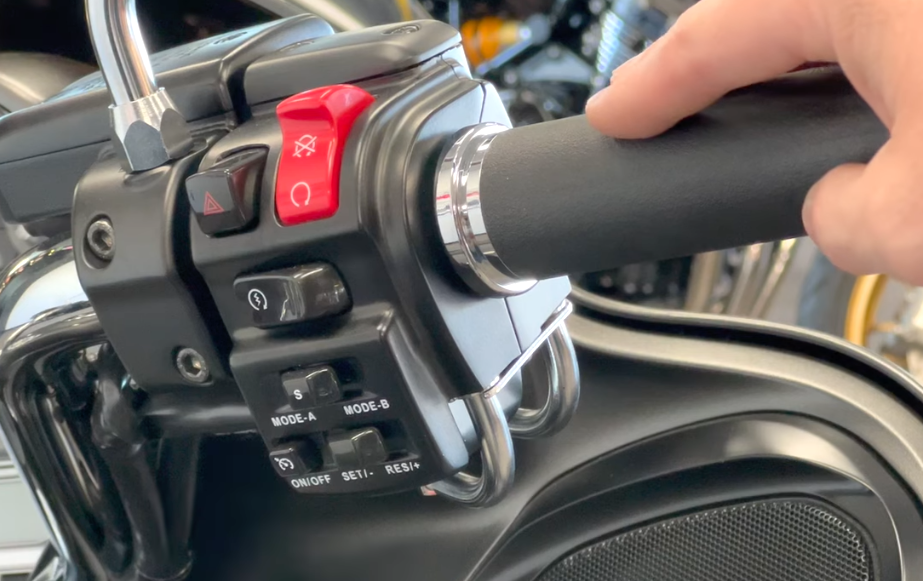
But the fun thing for me is every time I sit on a cruiser, there is nothing that feels like these bikes and I, that's why you guys are buying these things. So the overall comfort on a bike this big is really, really good. Even with this like, you know, very small non-existent windshield, you've got great wind protection overall, which makes long cruising, long, you know, highway rides super simple and of course you can put the big windshield up there and have it, you know, completely no wind at all if you wanted to. Overall, I'm about six feet tall, you can see pretty comfortable here. It's a nice wide uh, tank here. But again, very, very, very comfortable. And again, being six feet tall, my feet are easily on the ground. And of course these are pretty heavy bikes. So if you stop in a spot where there's a pothole or something like that, you want to have some room to put your feet down.
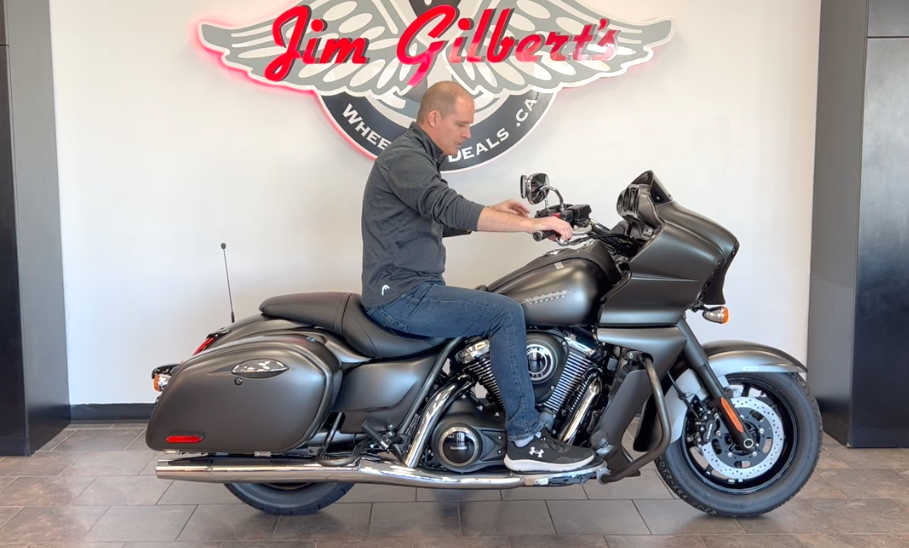
It's the kind of thing where you can buy the new Kawasaki without having to worry about did the previous owner do oil changes, did the previous owner take care of it? Do the things that you should do to a bike. You can buy this new for the price of other bikes used and you have a really, really good bike. Does it have the brand name that you want on a cruiser? Well, maybe it does, maybe it doesn't. The Vulcan Vaccaro though has a pretty good legacy in history, all on its own. So keep in mind there's, this is not a beginner bike. There are other cruisers in the lineup. The Vulcan S is a great first cruiser. It is very sporty and much lighter weight, much smaller. Then you can move up to the Vulcan, the 900 cc uh, engine, which really kind of is that in between bike.
It's really good for a lot of people. But this is kind of the king, that 1700 cc, it gives you that big engine kind of feel, that big engine sound. And again, it gives you that Kawasaki reliability Kawasaki dealer network and it's just a better value. So there's a lot of reasons that you would wanna buy this bike outside of the fact that it's a great value. Now people talk about, you know, has this been updated in a while, has it not? Well, I would argue that you don't really want to update this as the Kawasaki updates bikes traditionally in the rest of their lineup. You're getting things like a smoother engine. You're getting things like, you know, maybe a tiny bit more power here and there. But even on some of the top end bikes, there's not a ton of extra power over some of the nineties bikes and earlier.
And that's the thing with this, the 80 horsepower number, if that's about what it is, doesn't sound crazy impressive. But it doesn't matter on this because it's that 107 foot pounds of torque that actually is what you feel on any of these bikes. And it is an absolute torque monster compared to other bikes in lineup and other bikes that you could buy with similar styles. So really good, smooth revving, but still having that V twin feel, this is a cruiser that will satisfy your cruiser need and it's the kind of bike that you can just ride all day anywhere you want to go. And again, having the ability to add both the Kawasaki accessories, whether it's taking a passenger, whether it's larger windshields, whatever it is that you wanna do with this bike that's available. But having a bike that hasn't gone through as many changes allows the aftermarket to know that they can build stuff for this and get their return on their investment.
And there are so many accessories that you can get for this thing, both Kawasaki and otherwise. That mean that you can really take your cruiser and make it yours. The reality is, for me, the way this bike looks and it's, it's proven itself in this showroom, every time someone walks in and sees us, they're like, wow, that's a sharp looking cruiser. The Vaquero, the way it's laid out looks really good. So whether it's looks, whether it's style, whether it's the type of engine, whatever it is that you want, the Vaquero delivers and it's a great value. Is it right for you? Let me know when the comments below and if you have questions, make sure you let me know. Cause like I said, I'm here at Jim Gilbert's Power Sports, and I can come back to this bike again and again. This one is sold, but there is more coming in so you can come see them. And if you wanna see it in person, Swing by Jim Gilbert's Power Sports here in Fredericton, new Brunswick. And grab 'em for yourself. We'll talk to you in the next one.
Full Helpful Financing available..
